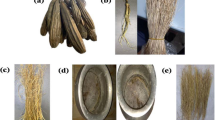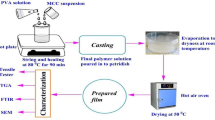Abstract
The present experimental study investigate the use of aloe vera gel as an innovative material to reinforce the degraded leather. The effectiveness of the proposed material was assessed by measuring the mechanical properties, color change, infrared spectroscopy, pH measurement, and microscopic examination. The results showed the effectiveness of the gel material in improving the tensile strength, elongation, and reducing the color change during the aging process without affecting the degree of pH as well as its ability to penetrate the fiber cells, which contributed to increase the size of fibers, fiber bundles, and the cohesion of internal structure of the leather as explained the results of SEM. Although gel has no effect in inhibiting the growth of fungi, it has helped reduce growth slightly.









Similar content being viewed by others
References
Syomiti, M. E., Maranga, E., Obwoyere, O. G., & Tegegn, G. G. (2014). Chemical composition of cactus (Opuntia ficus indica and Prosopis Species (Prosopis juliflora as drought resilient feed resources in Kenya. Journal of Environment Natural Resources Management and Society,2, 41–47.
Ennouri, M., Ammar, L., Khemakhem, B., & Attia, H. (2014). Chemical composition and antibacterial activity of Opuntia ficus-indica f. inermis (cactus pear) flowers. Journal of Medical Food,17(8), 908–914.
Chandra, S., Eklund, L., & Villarreal, R. (1998). Use of cactus in mortars and concrete. Cement and Concrete Research,28, 41–51.
Ventolà, L., Vendrell, M., Giraldez, P., & Merino, L. (2011). Traditional organic additives improve lime mortars: New old materials for restoration and building natural stone fabrics. Construction and Building Materials,25, 3313–3318.
Leon-Martinez, F. M., Cano-Barrita, P. F., Lagunez-Rivera, L., & Medina-Torres, L. (2014). Study of nopal mucilage and marine brown algae extract as viscosity-enhancing admixtures for cement based materials. Construction and Building Materials,53, 190–202.
El-Mostafa, K., El Kharrassi, Y., Badreddine, A., Andreoletti, P., & Vamecq, J. (2014). Nopal Cactus (Opuntia ficus-indica) as a source of bioactive compounds for nutrition.Health and Disease, Molecules,19, 14879–14901.
Martínez, U., Esparza, J., & Rodríguez-Fragoso, L. (2014). Cactus (Opuntia ficus-indica): A review on its antioxidants properties and potential pharmacological use in chronic diseases. Natural Products Chemistry and Research,2, 153–160.
Nayndamma, Y. (1958). Shrinkage Phenomena. In F. O’Flaherty, et al. (Eds.), The chemistry and technology of leather (pp. 28–65). New York: Reinhold.
Wouters, J., & Claeys, J. (1996). Analysis of tannins, sulphate, fat, moisture and ash: Evolution and significance of parameters to be followed for measuring the degradation of vegetable tanned leather. In R. Larsen (Ed.), Environment Leather Project (pp. 87–94). Copenhagen: Royal Danish Academy of Fine Arts.
Fathima, N., Dhathathreyan, A., & Ramasami, A Th. (2001). A new insight into the shrinkage phenomenon of hides and skins. Journal of the American Leather Chemists Association,96, 417–425.
Tuck, D. H. (1983). Oils and lubricants used on leather. Northampton: The leather Conservation Center.
Ayoub, S. M. (1982). A new molluscicide and al gicide from the fruit of acacia nilotica. Journal of Chemical Technology and Biotechnology,32, 728–734.
Faxing, L., Yang, L., & Youjie, H. (2005). Preparation and the properties of vegetable extract used in low temperature tanning. Leather Science and Engineering,15(1), 22–25.
Zaruwa, M. Z., & Kwaghe, Z. E. (2014). Traditional tannery and dyeing(Yirie) methods in Northeastern Nigeria. African Update Newsletter,15(1), 29–33.
Chae, Y., Chae, G., Youn, Y., Woo, S., Shin, S., & Lee, J. (2018). Optimal design of thickness and Young’s Modulus of multi-layered foldable structure considering bending stress, neutral plane and delamination under 2.5 mm radius of curvature. International Journal of Precision Engineering and Manufacturing,19(8), 1143–1154.
Kite, M., Thompson, R., & Angus, A. (2006). Materials and techniques: Past and present. In M. Kite & R. Thompson (Eds.), Conservation of leather and related materials (pp. 120–124). Oxford: Butterworth-Heinemann.
Sönmez, F., Başak, H., Güral, A., & Baday, S. (2018). Investigating the efficiency of secondary aging and burnishing process in friction stir welded Al-7075-T6 material. International Journal of Precision Engineering and Manufacturing,19(10), 1515–1520.
Larsen, R., Vest, M., & Nielsen, K. (1993). Determination of hydrothermal stability (shrinkage temperature) of historical leathers by Micro Hot Table technique. The Society of Leather Technologists and Chemists,77, 151–156.
Organisation in Internationale de Me´trologie Le´gale (1996). OIML, The scale of relative humidity of air certified against saturated salt solutions, OIML R.121,.P.7.
ISO 3376.(2011). Leather: Physical and mechanical tests—Determination of tensile strength and percentage extension.
Hassan, R. R., & Mohamed, W. S. (2017). Effect of methyl methacrylate/hydroxyethyl methacrylate copolymer on mechanical properties, optical and long-term durability of paper under accelerated ageing. International Journal of Conservation Science,8, 237–250.
Lucretia, M., Bogdan, L., Mihalis, B., Elena, C., & Ioana, S. (2016). Preliminary characterisation of vegetable leather used in heritage bindery. International Conference on Advanced Materials and Systems,5, 557–562.
Hassan, R. R., & Mohamed, W. S. (2018). The impact of methyl methacrylate hydroxyethyl methacrylate loaded with silver nanoparticles on mechanical properties of paper. Applied Physics A,124(8), 551.
Bauer, A. W., Kirby, W. M., Sherris, C., & Turck, M. (1966). Antibiotic susceptibility testing by a standardized single disk method.American Journal of Clinical Pathology,45, 493–496.
ASTM D2810-13, Standard Test Method for pH of Leather, ASTM International, West Conshohocken, PA, 2013, www.astm.org.
Koochakzaei, A., Ahmadi, H., & Achachluei, M. M. (2016). An experimental comparative study on silicone oil and polyethylene glycol as dry leather treatments. Journal-American Leather Chemists Association,111, 377–383.
Sizeland, K. H., Wells, H. C., Kelly, S. J. R., Edmonds, R. L., & Kirby, N. M. (2017). The influence of water, lanolin, urea, proline, paraffin and fat-liquor on collagen D-spacing in leather. RSC Advances,7, 40658–40663.
Sajjad, A., & Sajjad, S. S. (2014). Aloe vera: An ancient herb for modern dentistry—A literature review. Journal of Dental Surgery. https://doi.org/10.1155/2014/210463.
Beier, G., Niehoff, S., Ziems, T., & Xue, B. (2017). Sustainability aspects of a digitalized industry—A comparative study from China and Germany. International Journal of Precision Engineering and Manufacturing-Green Technology,4(2), 227–234.
Kang, H. S., Lee, J. Y., Choi, S., Kim, H., & Park, J. H. (2016). Smart manufacturing: Past research, present findings, and future directions. Journal of Precision Engineering and Manufacturing-Green Technology,3(1), 111–128.
Florian, M. L. E. (2006). The mechanisms of deterioration of leather. In M. Kite & R. Thompson (Eds.), Conservation of leather and related materials (pp. 36–54). Oxford: Butterworth-Heinemann.
Hassan, R. R. (2016). Preliminary study on using line seed oil emulsion in dressing archaeological leather. Journal of Cultural Heritage,21, 786–795.
Cantero, R., Riba, J. R., Canals, T., & Izquierdo, L. L. (2009). Characterisation of leather finishing by IR spectroscopy and canonical variate analysis. Journal of the Society of Leather Technologists and Chemists,93(1), 12.
Puică, N. M., & Florescu, A. M. (2006). FTIR Spectroscopy for the analysis of vegetable tanned ancient leather. European Journal of Science and Theology,2(4), 49–53.
Samadi, P. Y. (2011). Moist heating-induced changes in protein molecular structure, protein sub fraction, and nutrient profiles in soybeans.Journal of Dairy Science,94(12), 6092–60102.
Malea, E. S., Boyatzis, C., & Kehagia, M.(2010). Cleaning of tanned leather: Testing with infra red spectroscopy and SEM-EDAX, joint interim meeting of five ICOM-CC working groups. Leather and Related materials. Rome (pp. 1–12).
Hassan, R. R. (2015). Tafsir Al khazen” manuscript (17 th century AD. A technical study International Journal of Conservation Science,6(3), 369–382.
Tite, T., Miu, L., Giurginca, M., & Meghea, A. (2006). Evaluation of degradation of parchment and leather by FT-IR and UV-VIS-NIR spectroscopy. Revista de Chimie-Bucharest-Original Edition,57(5), 466–471.
Mansour, M., Hassan, R. R., & Salem, M. (2017). Characterization of historical bookbinding leather by FTIR, SEM and EDX, and investigation of fungal species isolated from the leather. Egyptian Journal of Archaeological and Restoration Studies,7(1), 1–10.
Vetter, W., Petroviciu, I., Ciprian,C., Miu, L., & Schreiner M. (2010). Characterization of leather by UV-VIS spectroscopy and MHT method. InProceedings of the 3rd international conference on advanced materials and systems, ICAMS (pp. 463–468).
Yagi, A., Egusa, T., Arase, M., Tanabe, M., & Tsuji, H. (1997). Isolation and characterization of the glycoprotein fraction with a proliferation-promoting activity on human and hamster cells in vitro from aloe vera gel. Planta Medica,63(1), 18–21.
Sham, A. S., Chu, F. C., Chai, J. J., & Chow, T. W. (2004). Color stability of provisional prosthodontic materials. Journal of Prosthetic Dentistry,9, 1447–1452.
Choi, S., Lee, P., & Jhang, K. (2019). A pulse inversion-based nonlinear ultrasonic technique using a single-cycle longitudinal wave for evaluating localized material degradation in plates. International Journal of Precision Engineering and Manufacturing,20, 549–558.
Ahmed, H. E., Zidan, Y., & El-Nagar, K. (2005). Studies on dyeing with cochineal and ageing of silk dyed fabric. In R. Janaway & P. Wyeth (Eds.), Scientific analysis of ancient and historic textiles (pp. 246–250). London: Archetype Publications.
Fani, M., & Kohanteb, J. (2012). Inhibitory activity of aloe vera gel on some clinically isolated cariogenic and periodontopathic bacteria.Journal of Oral Science,54(1), 15–21.
Athiban, P. P., Borthakur, B. J., Ganesan, S., & Swathika, B. (2012). Evaluation of antimicrobial efficacy of aloe vera and its effectiveness in decontaminating gutta percha cones. Journal of Conservative Dentistry,15(3), 246–248.
Barandozi, F. N. (2013). Antibacterial activities and antioxidant capacity of Aloe vera. Organic and Medical Chemistry Letters,193(1), 5–10.
Author information
Authors and Affiliations
Corresponding author
Additional information
Publisher's Note
Springer Nature remains neutral with regard to jurisdictional claims in published maps and institutional affiliations.
Rights and permissions
About this article
Cite this article
Hassan, R. In Vitro Study for Use of Cactus Gel in Enhancing the Mechanical Strengths of Vegetable Tanned Leathers Under Accelerated Aging. Int. J. Precis. Eng. Manuf. 21, 145–155 (2020). https://doi.org/10.1007/s12541-019-00178-x
Received:
Revised:
Accepted:
Published:
Issue Date:
DOI: https://doi.org/10.1007/s12541-019-00178-x




